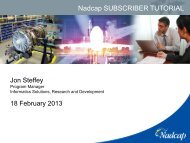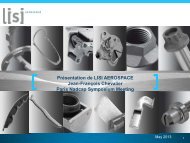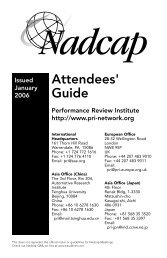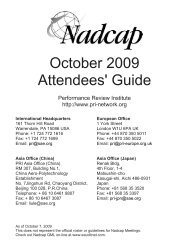Problem Solving Tools: 5 Why 1 - Performance Review Institute
Problem Solving Tools: 5 Why 1 - Performance Review Institute
Problem Solving Tools: 5 Why 1 - Performance Review Institute
You also want an ePaper? Increase the reach of your titles
YUMPU automatically turns print PDFs into web optimized ePapers that Google loves.
2<br />
<strong>Problem</strong> <strong>Solving</strong> <strong>Tools</strong>: 5 <strong>Why</strong><br />
Perspective<br />
Test the Chain<br />
Once you have reached what you feel is the Root Cause of<br />
the problem, it is important to test the chain, to check you<br />
have not missed anything. This is easy to do: it is as simple<br />
as climbing back up the chain and asking if the cause<br />
makes the result inevitable.<br />
Root Cause: The babysitter was helping to clean the<br />
house<br />
This caused the kids to play unsupervised<br />
This caused the kids to be able to play in the car and leave<br />
the door ajar<br />
This caused the interior light to be on all night<br />
This caused the battery to die<br />
This caused the car to not start<br />
This caused the event: not getting to work on time<br />
Do I have to ask why 5 times<br />
This is a simple chain of 5 questions which lead to the<br />
Root Cause distracting the babysitter from doing her job;<br />
looking after the children. However the 5 <strong>Why</strong> technique<br />
does not need 5 <strong>Why</strong>s every time; it can be as many or<br />
as few <strong>Why</strong>s as is necessary to find the Root Cause of the<br />
problem.<br />
It may also be that there is more than one chain with<br />
more than one Root Cause. This problem could have<br />
branches breaking off from it at various levels.<br />
Q: <strong>Why</strong> were you late<br />
A: The car wouldn’t start<br />
Q: <strong>Why</strong> didn’t the car start<br />
A: The battery was dead<br />
Q: <strong>Why</strong> was the battery dead<br />
A: The kids played in the car and left the door ajar<br />
Q: <strong>Why</strong> were the kids playing in the car<br />
A: The babysitter wasn’t watching them<br />
Q: <strong>Why</strong> wasn’t the babysitter watching them<br />
RC: Babysitter was asked to help clean the house.<br />
Guidelines for ending your chain<br />
It is important to remember when using this technique<br />
not to go too far in asking <strong>Why</strong>. If you ask <strong>Why</strong> too<br />
many times, this can result in<br />
silly answers. Your answers must<br />
remain within your control and<br />
must be workable. In this example,<br />
we have reached a very workable<br />
Root Cause of the problem of<br />
being late with a simple and<br />
controllable solution: of leaving<br />
the babysitter to do her job.<br />
Q: <strong>Why</strong> didn’t you take a bus<br />
A: I did not know the bus routes<br />
Q: <strong>Why</strong> did you not know the bus routes<br />
RC: I never had a contingency for the car breaking down<br />
A: The battery was old<br />
Q: <strong>Why</strong> was it not replaced<br />
RC: I never get the car battery checked<br />
Conclusion<br />
A Root Cause is the fundamental reason for an event<br />
which, if corrected, would prevent recurrence. There<br />
may be more than one Root Cause to a problem, so it<br />
is important to let the chain lead itself to the final Root<br />
Cause.<br />
And if you are still wondering, you start from the ground<br />
floor and work your way up to the top.<br />
PRI offers professional development opportunities at<br />
convenient regional locations or at your facility.<br />
For additional information and complete training<br />
schedules, visit www.eQuaLearn.com<br />
© <strong>Performance</strong> <strong>Review</strong> <strong>Institute</strong> 2011
















